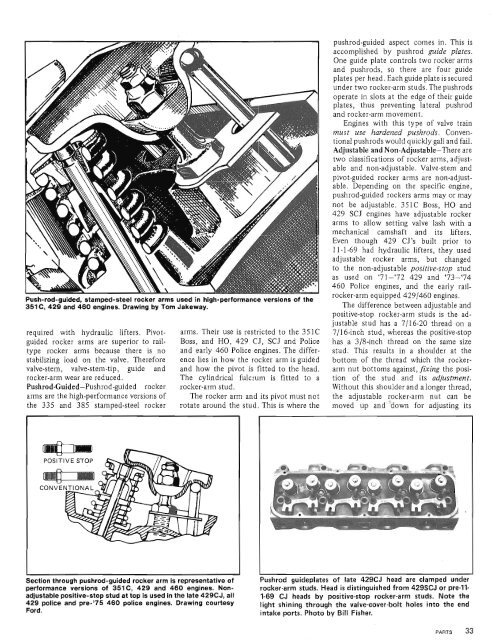How To Rebuild Your Ford V-8 351C-351M-400-429-460.pdf - Index of
How To Rebuild Your Ford V-8 351C-351M-400-429-460.pdf - Index of
How To Rebuild Your Ford V-8 351C-351M-400-429-460.pdf - Index of
You also want an ePaper? Increase the reach of your titles
YUMPU automatically turns print PDFs into web optimized ePapers that Google loves.
pushrod-guided aspect comes in. This is<br />
accomplished by pushrod guide plates.<br />
One guide plate controls two rocker arms<br />
and pushrods, so there are four guide<br />
plates per head. Each guide plate is secured<br />
under two rocker-arm studs. The pushrods<br />
operate in slots at the edge <strong>of</strong> their guide<br />
plates, thus preventing lateral pushrod<br />
and rocker-arm movement.<br />
Engines with this type <strong>of</strong> valve train<br />
must use hardened pushrods. Conventional<br />
pushrods would quickly gall and fail.<br />
Adjustable and Non-Adjustable-There are<br />
two classifications <strong>of</strong> rocker arms, adjustable<br />
and non-adjustable. Valve-stem and<br />
pivot-guided rocker arms are non-adjustable.<br />
Depending on the specific engine,<br />
pushrod-guided rockers arms may or may<br />
not be adjustable. <strong>351C</strong> Boss, HO and<br />
<strong>429</strong> SCJ engines have adjustable rocker<br />
arms to allow setting valve lash with a<br />
mechanical camshaft and its lifters.<br />
Even though <strong>429</strong> CJ's built prior to<br />
11-1-69 had hydraulic lifters, they used<br />
adjustable rocker arms, but changed<br />
to the non-adjustable positive-stop stud<br />
as used on '71-'72 <strong>429</strong> and '73-'74<br />
460 Police engines, and the early railrocker-arm<br />
equipped <strong>429</strong>1460 engines.<br />
Push-rod-guided, stamped-steel rocker arms used in high-performance versions <strong>of</strong> the<br />
351 C, <strong>429</strong> and 460 engines. - Drawing - by - <strong>To</strong>m Jakeway.<br />
The difference between adjustable and<br />
positive-stop rocker-arm studs is the adjustable<br />
stud has a 7/16-20 thread on a<br />
required with hydraulic lifters. Pivot- arms. Their use is restricted to the <strong>351C</strong> 7116-inch stud, whereas the positive-stop<br />
guided rocker arms are superior to rail- Boss, and HO, <strong>429</strong> CJ, SCJ and Police has a 318-inch thread on the same size<br />
type rocker arms because there is no and early 460 Police engines. The differ- stud. This results in a shoulder at the<br />
stabilizing load on the valve. Therefore ence lies in how the rocker arm is guided bottom <strong>of</strong> the thread which the rockervalve-stem,<br />
valve-stem-tip, guide and and how the pivot is fitted to the head. arm nut bottoms against, fixing the posirocker-arm<br />
wear are reduced. The cylindrical fulcrum is fitted to a tion <strong>of</strong> the stud and its adjustment.<br />
Pushrod-Guided-Pushrod-guided rocker rocker-arm stud. Without this shoulder and alonger thread,<br />
arms are the high-performance versions <strong>of</strong> The rocker arm and its pivot must not the adjustable rocker-arm nut can be<br />
the 335 and 385 stamped-steel rocker rotate around the stud. This is where the moved up and 'down for adjusting its<br />
Section through pushrod-guided rocker arm is representative <strong>of</strong><br />
performance versions <strong>of</strong> <strong>351C</strong>, <strong>429</strong> and 460 engines. Nonadjustable<br />
positive-stop stud at top Is used in the late <strong>429</strong>CJ, all<br />
<strong>429</strong> police and pre-'75 460 police engines. Drawing courtesy<br />
<strong>Ford</strong>.<br />
Pushrod guideplates <strong>of</strong> late <strong>429</strong>CJ head are clamped under<br />
rocker-arm studs. Head is distinguished from <strong>429</strong>SCJ or pre-ll-<br />
1-69 CJ heads by positive-stop rocker-arm studs. Note the<br />
light shining through the valve-cover-bolt holes into the end<br />
intake ports. Photo by Bill Fisher.
















